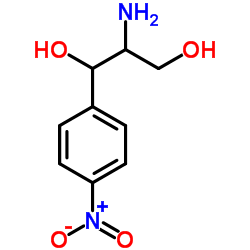1-(p-nitrophenyl)-2-amino-1,3-propanediol

1-(p-nitrophenyl)-2-amino-1,3-propanediol structure
|
Common Name | 1-(p-nitrophenyl)-2-amino-1,3-propanediol | ||
|---|---|---|---|---|
| CAS Number | 2964-48-9 | Molecular Weight | 212.203 | |
| Density | 1.4±0.1 g/cm3 | Boiling Point | 451.9±45.0 °C at 760 mmHg | |
| Molecular Formula | C9H12N2O4 | Melting Point | 163-166ºC(lit.) | |
| MSDS | USA | Flash Point | 227.1±28.7 °C | |
| Name | [(1S,2S)-1,3-dihydroxy-1-(4-nitrophenyl)propan-2-yl]azanium |
|---|---|
| Synonym | More Synonyms |
| Density | 1.4±0.1 g/cm3 |
|---|---|
| Boiling Point | 451.9±45.0 °C at 760 mmHg |
| Melting Point | 163-166ºC(lit.) |
| Molecular Formula | C9H12N2O4 |
| Molecular Weight | 212.203 |
| Flash Point | 227.1±28.7 °C |
| Exact Mass | 212.079712 |
| PSA | 112.30000 |
| LogP | 0.13 |
| Vapour Pressure | 0.0±1.2 mmHg at 25°C |
| Index of Refraction | 1.630 |
| Safety Phrases | S22-S24/25 |
|---|---|
| RIDADR | NONH for all modes of transport |
| WGK Germany | 3 |
|
[Studies on the resolution of racemic gossypol. IV. Use of threo (-) or (+)-1-(p-nitrophenyl)-1,3-dihydroxypropylamine-2 as the resolving agent].
Yao Xue Xue Bao 25(6) , 430-4, (1990) Threo (-) or (+)-1-(p-nitrophenyl)-1,3-dihydroxypropylamine-2 was found to be a useful resolving agent for racemic gossypol. The optical and chemical stability of the condensate of enantiomeric gossyp... |
|
|
Investigation of Batten disease with the yeast Saccharomyces cerevisiae.
Mol. Genet. Metab. 66(4) , 314-9, (1999) The CLN3 gene, which encodes the protein whose absence is responsible for Batten disease, the most common inherited neurovisceral storage disease of childhood, was identified in 1995. The function of ... |
|
|
High-performance liquid chromatographic determination of chloramphenicol and 2-amino-1-(p-nitrophenyl)-1,3-propanediol in pharmaceutical formulations.
J. Chromatogr. A. 170(1) , 282-7, (1979)
|
| 2-Amino-1-(4-nitrophenyl)-1,3-propanediol |
| (-)-(1R,2R)-1-para-nitrophenyl-2-amino-1,3-propanediol |
| L-(+)-threo-2-Amino-1-(4-nitrophenyl)-1,3-propanediol |
| 2-amino-1-(4-nitrophenyl)propane-1,3-diol |
| D-(-)-threo-2-Amino-1-(p-nitrophenyl)-1,3-propanediol |
| Threomine |
| (1R,2R)-(-)-2-amino-1-(4-nitrophenyl)-1,3-propanediol |
| D-threo-2-Amino-1-(4-nitrophenyl)-1,3-propanediol |
| D-threo-(-)-2-Amino-1-(p-nitrophenyl)-1,3-propanediol |
| MFCD00007359 |
| 1-(p-nitrophenyl)-2-amino-1,3-propanediol |
| (-)-(1R,2R)-1-(4'-nitrophenyl)-2-amino-1,3-propanediol |
| (1S,2S)-(+)-2-Amino-1-(4-nitrophenyl)-1,3-propanediol |
| (1S2S)-2-AMINO-1-(4-NITROPHENYL)PROPANE-13-DIOL |
| 1,3-Propanediol, 2-amino-1- (p-nitrophenyl)- |
| 1,3-Propanediol, 2-amino-1-(p-nitrophenyl)-, D-threo-(-)- |
| (1S,2S) |
| EINECS 221-001-4 |
| (1S,2S)-2-Amino-1-(p-nitrophenyl)-1,3-propanediol |
| Adenosine DisopiuM Triphosphate |
| (2S)-2-aMino-1-(4-nitrophenyl)propane-1,3-diol |
| 1,3-Propanediol, 2-amino-1-(4-nitrophenyl)- |
| (2R,3R)-2-amino-3-hydroxy-3-(p-nitrophenyl)-1-propanol |
| (1S,2S)-2-Amino-1-(4-nitrophenyl)propane-1,3-diol |
| D-(+)-threo-1-P-nitrophenyl-2-amino-1,3-propanediol |
| [S(R*,R*)]-2-amino-1-(p-nitrophenyl)propane-1,3-diol |
| D-(-)-threo-2-amino-1-(4-nitrophenyl)-1,3-propanediol |
| 1,3-Propanediol, 2-amino-1- (4-nitrophenyl)- |
| L-BASE |

